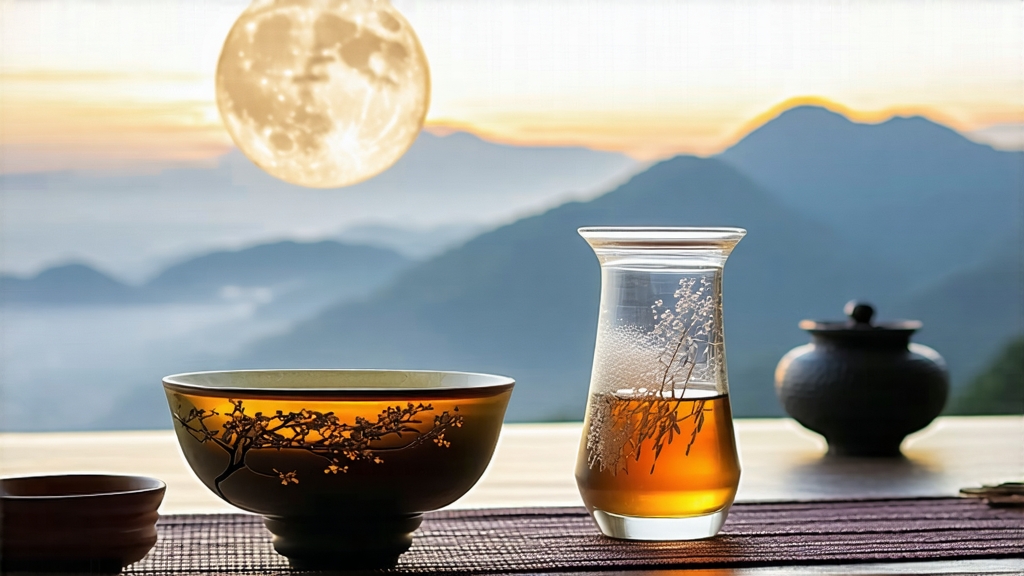
Tucked high on the forested ridges of southern Yunnan, where the Mekong carves silver ribbons through subtropical cloud forest, a tea has been quietly absorbing moonlight for almost three centuries. International drinkers often equate “white tea” with the downy buds of Fujian’s Silver Needle, yet 1,200 km to the west a cultivar called Camellia taliensis offers a different interpretation: Yue Guang Bai—literally “Moonlight White.” Its leaves are one-sidedly silver, the other a charcoal-lavender, as though brushed by the moon itself. This essay invites you to explore that twilight leaf: its mythic origins, the craft that keeps it alive, and the gentle rituals that coax its fragrance into porcelain.
-
Historical whispers
Local Dai, Hani and Lahu communities tell two complementary stories. The first speaks of caravan eras when Pu-erh bricks were pressed under starlight to avoid daytime heat; tea accidentally left uncovered absorbed dew and moonlight, acquiring a sweeter, rounder character. The second credits a 19th-century tea maiden named Nanmei who, forbidden to see her lover by day, plucked leaves after dusk, withering them on woven bamboo beneath the moon. Whatever the truth, written records from 1903 mention “moon-cured buds” presented to the Tusi of Cheli (today’s Jinghong), and 1936 county annals list “bai ya yue zhan” among tributes. Only in 2003 did Kunming exporters coin the English name “Moonlight White,” launching it into global specialty circles. -
Terroir and cultivar difference
Unlike Fujian white tea built on C. sinensis var. sinensis, Yue Guang Bai relies on C. taliensis, a larger-leaf species native to 1,600–2,000 m elevations. The leaves are 30 % longer, with fewer stomata, allowing slower withering and higher accumulation of L-theanine. Soils are lateritic, rich in iron and potassium; diurnal swings of 12 °C lock in floral precursors. Ancient tea gardens—many over 300 years old—are inter-cropped with dragon plum and wild pepper trees, whose roots share mycorrhizal networks believed to impart subtle spice notes. -
Plucking standards
Authentic Moonlight White is harvested in two brief windows: the “spring moon” (March 15–April 15) and the “autumn moon” (September 20–October 20). Pickers select one bud plus the first unfolded leaf (grades Y1) for the finest lots, or one bud with two leaves (Y2) for everyday drinking. Plucking begins at 19:30 when leaf temperature drops to 18 °C, reducing enzymatic browning and keeping the bud’s trichomes intact. -
Craft: the nocturnal wither
The magic lies in a 48-hour moon-wither, unique among white teas. Leaves are laid 2 cm deep on bamboo trays stacked inside open-walled sheds oriented east-west. Night breezes (65–70 % relative humidity) pass through, carrying forest volatiles; moonlight provides a faint photosynthetic stimulus that alters chlorophyll degradation pathways, yielding the characteristic mottled colour. At dawn the tea master covers trays with hemp cloth to block direct sun, preventing “greening.” After 36 hours the leaf moisture falls to 40 %; an additional 12 hours of gentle warmth from an under-floor charcoal trough finishes the job at 8 % without ever exceeding 32 °C. No rolling, no frying—only stillness, air and time. -
Oxidation: the silent 10 %
Although classed as white tea, Moonlight White undergoes roughly 8–12 % enzymatic oxidation, higher than Fujian counterparts. This edge oxidation, happening during the second night, transmutes catechins into theaflavins, explaining the peach-skin hue of the liquor and its honeyed finish. Master crafters test readiness by rolling a leaf between palms: when the lamina cracks but the vein remains pliable, oxidation is halted simply by moving the leaf into a low-humidity drying room. -
Drying and resting
Unlike conventional 70 °C hot-air drying, Moonlight White is finished at 38 °C for four hours, mimicking Yunnan’s natural afternoon mountain heat. The tea then “dreams” for a minimum of 20 days